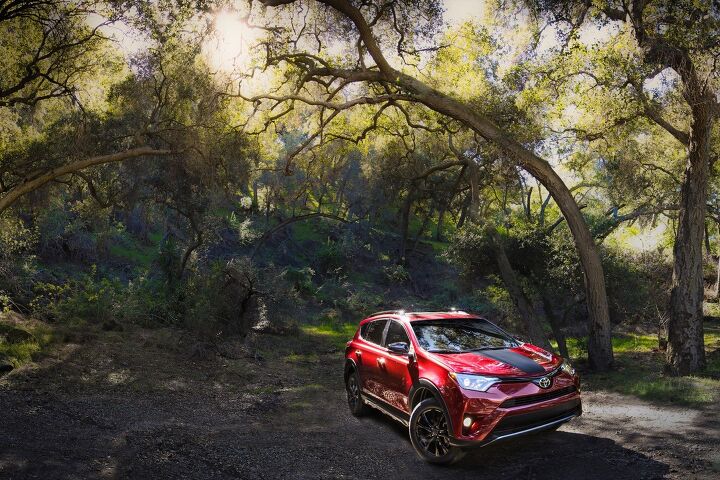The 2018 Toyota RAV4 Adventure Is No Niche Market Special Edition - It'll Be More Popular Than Most SUVs
In late 2015, Toyota revealed that the automaker’s increasingly popular RAV4 would be increasingly leaned upon for major U.S. sales volume.
As of five years ago, Toyota USA had never sold more than 200,000 RAV4s on an annual basis. Toyota didn’t touch the 300,000 marker until 2015.
But the goal set in 2015 was loftier: 400,000 U.S. sales of the RAV4 in 2018. An SE trim level helped. Then the RAV4 Hybrid became a real success. Toyota sold 352,154 RAV4s in 2016 and is on track for 380,000 sales in 2017.
What will put the Toyota RAV4 over the hump?
If all goes according to plan, the 2018 Toyota RAV4 Adventure that goes on sale in September won’t be a mere oddball offshoot.
According to Automotive News, the elevated, fender-flared, tow-package-equipped RAV4 that Toyota revealed at the Chicago Auto Show last February is targeted for 40,000 annual U.S. sales.
Toyota is watching while passenger car buyers flee the midsize arena during the 2018 Camry’s launch year. Boosting the volume of the vehicle most likely to take over — the vehicle that’s already taken over — from the Camry as Toyota’s best-selling vehicle is a surefire way to reduce the sting.
Granted, some of those 40,000 RAV4 Adventure (aka RAV4 Trail) sales will siphon away sales of conventional RAV4s. But the goal for 40,000 RAV4 Adventures still means roughly 10 percent of RAV4 volume heading the Adventure’s way.
On its own, Toyota’s goal of 40,000 RAV4 Adventure sales means this one, unique RAV4 trim level will be more common than roughly half of all SUV/crossover nameplates on sale in America. For perspective, Volkswagen sold nearly 44,000 Tiguans in 2016, its best year ever. Mitsubishi sold 26,576 Outlanders. Mazda sold fewer than 19,000 CX-3s. Mini sold fewer than 13,000 Countrymans.
Laugh at the RAV4 Adventure if you must. But Toyota’s going to laugh all the way to the bank.
Timothy Cain is a contributing analyst at The Truth About Cars and Autofocus.ca and the founder and former editor of GoodCarBadCar.net. Follow on Twitter @timcaincars.
More by Timothy Cain
Latest Car Reviews
Read moreLatest Product Reviews
Read moreRecent Comments
- Lorenzo I shop for all-season tires that have good wet and dry pavement grip and use them year-round. Nothing works on black ice, and I stopped driving in snow long ago - I'll wait until the streets and highways are plowed, when all-seasons are good enough. After all, I don't live in Canada or deep in the snow zone.
- FormerFF I’m in Atlanta. The summers go on in April and come off in October. I have a Cayman that stays on summer tires year round and gets driven on winter days when the temperature gets above 45 F and it’s dry, which is usually at least once a week.
- Kwik_Shift_Pro4X I've never driven anything that would justify having summer tires.
- Scotes So I’ll bite on a real world example… 2020 BMW M340i. Michelin Pilot Sport 4S. At 40k now and I replaced them at about 20k. Note this is the staggered setup on rwd. They stick like glue when they are new and when they are warm. Usually the second winter when temps drop below 50/60 in the mornings they definitely feel like they are not awake and up to the task and noise really becomes an issue as the wear sets in. As I’ve made it through this rainy season here in LA will ride them out for the summer but thinking to go Continental DWS before the next cold/rainy season. Thoughts? Discuss.
- Merc190 The best looking Passat in my opinion. Even more so if this were brown. And cloth seats. And um well you know the best rest and it doesn't involve any electronics...


































Comments
Join the conversation
Toyota needs to become more competitive in that they cannot afford to rest on their past. Better interiors and more attractive designs would be a start. The crossover market is a growing market with growing competition. It is too important to just make a few changes and call it a new model. Honda introduced a new redesigned CRV and even Chevrolet has a new Equinox. Toyota cannot afford to rest on their past accomplishments and not all customers buy a vehicle without looking at the competition.
Don't understand your comment, the new CRV is selling well. The RAV4 is selling well but as stated above it has some competition and should not rest on the past.